Bog Myrtle (Sweet Gale)
By Mike on Sunday, July 22, 2012, 22:16 - Permalink
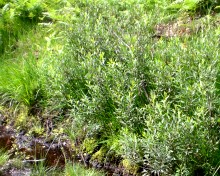 This summer of rain finally let up, so we headed off to the New Forest for a walk; I picked some Bog Myrtle to make Gale Beer.
This summer of rain finally let up, so we headed off to the New Forest for a walk; I picked some Bog Myrtle to make Gale Beer.
What Is Bog Myrtle?
Myrica gale - Also known as Sweet Gale is a wiry shrub common on peaty lowlands, river margins and bogs, growing to about 3 feet tall.
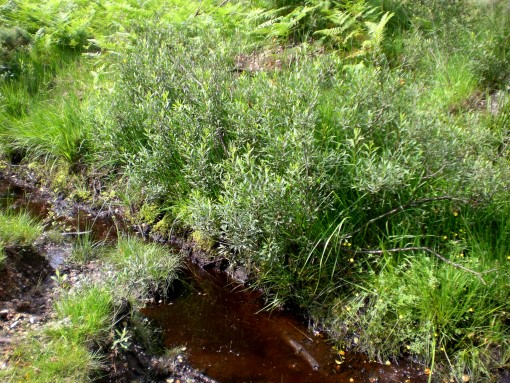
Before the introduction of hops to Britain, Sweet Gale was used to flavour and preserve beer - and that's what I'll be trying.
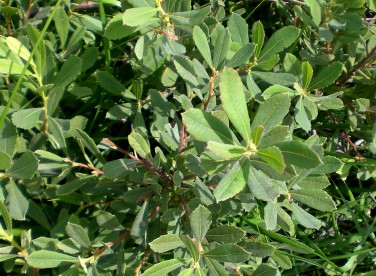 The dull green leaves (pale green underneath) are strongly aromatic when crushed, having a spicy resinous smell.
The dull green leaves (pale green underneath) are strongly aromatic when crushed, having a spicy resinous smell.
The small waxy fruits - produced later in the year - have historically been gathered to use in the production of candles. This sounds like a lot of work, but I might give it a try sometime.
Making Gale Beer
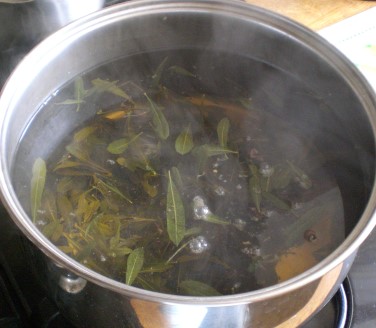 I gathered a few sprigs of leaves - totalling about a double handful when stripped from the twigs.
I gathered a few sprigs of leaves - totalling about a double handful when stripped from the twigs.
I boiled a large pan of water, then dropped in the leaves and left them to steep for ten minutes.
 Meanwhile (brewing purists please look away now) I put 1.5kg of spray dried malt in a large fermenting bucket, together with three big spoonfuls of black treacle and another three spoons of honey.
Meanwhile (brewing purists please look away now) I put 1.5kg of spray dried malt in a large fermenting bucket, together with three big spoonfuls of black treacle and another three spoons of honey.
I dissolved these sugars in a few litres of cooled boiled water, which I topped up to 20 litres with more boiled water and the strained infusion of Sweet Gale. (In fact, I steeped the strained leaves in a further two pans of water during the process, to maximise the extraction).
 I left the bucket covered to cool (this took a dozen hours - 20 litres of water holds a lot of heat), then I added the beer yeast, covered it again and left it to work.
I left the bucket covered to cool (this took a dozen hours - 20 litres of water holds a lot of heat), then I added the beer yeast, covered it again and left it to work.
At this stage, the aroma of the Sweet Gale was quite discernible - it's got an almost gingery scent.
 The next day, I peeked under the lid and it was fizzing and bubbling away nicely.
The next day, I peeked under the lid and it was fizzing and bubbling away nicely.
I had expected there to be a foamy layer of yeast working on the top, but there wasn't - it may just be that this strain of yeast is a bottom-working one, or maybe there's something about the slightly waxy resinous nature of the Sweet Gale that makes it do this.
After a week, fermentation subsided and the beer cleared - I set about bottling it.
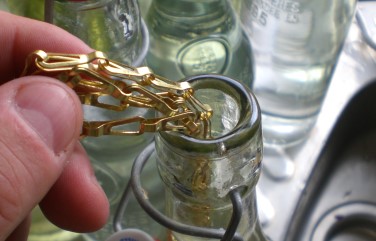 I've got loads of 1 litre clamp-top bottles, but they need a really thorough clean and I couldn't find a long enough bottle brush, so instead, I got a piece of brass lamp chain and cleaned each bottle by quarter-filling with detergent and water, then swirling around vigorously, so the chain scoured the insides clean.
I've got loads of 1 litre clamp-top bottles, but they need a really thorough clean and I couldn't find a long enough bottle brush, so instead, I got a piece of brass lamp chain and cleaned each bottle by quarter-filling with detergent and water, then swirling around vigorously, so the chain scoured the insides clean.
 Once the bottles were cleaned and sterilised, I added a heaped teaspoonful of white sugar to each one.
Once the bottles were cleaned and sterilised, I added a heaped teaspoonful of white sugar to each one.
This will permit the yeast to work just a little bit more - and in the enclosed environment of the sealed bottle, this will force Carbon Dioxide into solution, hopefully giving the brew a bit of sparkle.
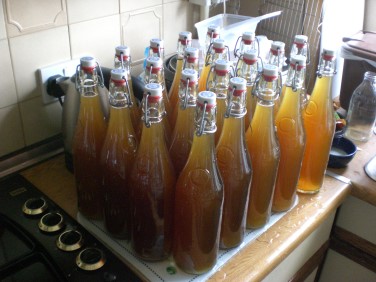 I siphoned the beer into bottles - 21 of them, but despite my great care, it still looked a bit cloudy - maybe I should have left it longer to clear.
I siphoned the beer into bottles - 21 of them, but despite my great care, it still looked a bit cloudy - maybe I should have left it longer to clear.
But I didn't want to wait too long in case it spoiled once fermentation was over - too late to go back now, so I stacked the bottles in a crate and moved them downstairs to the cool and dark of the garage.
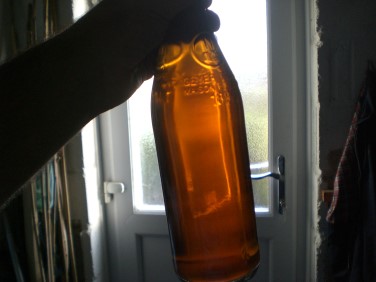 Another week, and things were looking good - the beer is looking quite bright and clear - with the cloudiness having settled to the bottom.
Another week, and things were looking good - the beer is looking quite bright and clear - with the cloudiness having settled to the bottom.
Obviously, this means there will be a thin layer of sediment at the bottom, but that's normal for a bottle-conditioned ale. I just need to leave it now for at least a few more weeks - the sediment layer will 'set' on the bottom so it doesn't get mixed back in when the beer is poured.
I Couldn't Wait
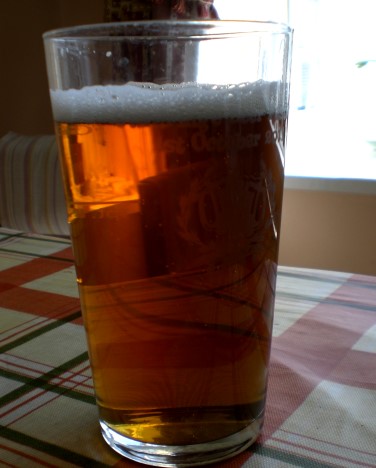 5th August 2012 - I couldn't resist cracking open a bottle - the lid flipped open with a satisfying pop!, and bubbles started to rise inside.
5th August 2012 - I couldn't resist cracking open a bottle - the lid flipped open with a satisfying pop!, and bubbles started to rise inside.
I poured myself a pint of foaming Bog Myrtle Ale - it's really good - malty, with just the right balance of acidity and sweetness. The spicy aroma and slightly bitter taste of the Bog Myrtle makes it a tasty and refreshing brew.
The sediment from bottle-conditioning hadn't completely set - this isn't a problem if the contents are poured in a single movement (i.e. nearly two pint glasses) - setting it back upright and pouring again was enough to disturb it and make the second pour a bit cloudy.
I didn't bother with the necessary measurements to be able to empirically state the alcoholic strength of this beer, but judging solely by flavour and 'feel', I'd say it must be somewhere around 4.5% ABV.
